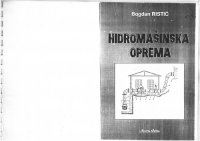
Ebook: Hidromašinska oprema
Author: Bogdan Ristić
- Genre: Technique // Mechanical Engineering
- Tags: Hydropower hydromechanical equipment
- Year: 1996
- Publisher: IP "Naučna knjiga"
- City: Belgrade
- Language: Serbian
- pdf
Sharing is Caring!
Content:
I HEAD - Hydroenergetic systems
I.1. Hydropower Plants
I.2. Pump Stations
II HEAD - Hydromechanical equipment
II.1. HME Classification
II.2. Basic layout of HME on object
II.3. Water intakes
II.4. Trashracks and maintenance
II.4.1. Trashracks
II.4.2. Cleaning
II.5. Organs for closure hydrotechnical objects
II.5.1. Hydraulic gates
II.5.2. Types of gates and classification
II.5.3. Main conditions for working and force on gates
II.5.4. Slide gates
II.5.4.1. Wood slide gates
II.5.4.2. Steel slide gates
II.5.4.3. Work methods of gates
II.5.4.4. Technical and economical comparison of gates
II.5.5. Radial gates
II.5.5.1. Description and purpose of radial gates
II.5.5.2. Surface radial gates
II.5.5.3. Radial gate for bottom outlets
II.5.5.4. Weight of gates
II.5.5.5. Radial gates caracteristics
II.5.5.6. Automatization of radial gates
II.5.6. Sector gates
II.5.6.1. Description
II.5.6.2. Stability of sector gates with joint connection downstream of sector gate
II.5.6.3. Weight and raiting of quality
II.5.7. Special gates for micropower plants and temporary hydraulic objects
II.5.7.1. Semiautomatic gates
II.5.7.2. Automatic butterfy gates
II.5.8. Gate sealing
II.5.8.1. Generalized about gates seal
II.5.9. Work with gates
II.5.10. Mechanical estimate
II.6. Pipeline valves
II.6.1. Needs for valves and valve type
II.6.2. Valves
II.6.2.1. Description and caracteristics
II.6.3. Butterfly valves
II.6.3.1. General about butterfly valves
II.6.3.2. Butterfly valves estimate
II.6.4. Needle valves
II.6.5. Sleeve valves
II.6.6. Working with valves
II.6.6.1. Mechanical work with valves
II.6.6.2. Manual drive
II.6.6.3. Automatic emergency closure
II.6.6.4. Handwheel drive open and close
II.6.7. Non-return valves
II.6.7.1. General about non-return valves
II.6.7.2. Non-return valve estimate
II.6.7.3. Dynamic behavior of non-return valve during waterhamer
II.6.7.3.1. Dynamic of non-return valve
II.6.7.3.2. Closure time
II.6.7.3.3. Time of water outflow through the pipeline
II.6.8. Comparation between gate mass and investition cost
III HEAD - PIPES UNDER PRESSURE
III.1. Position scheme and types of penstocks
III.2. Penstock estimate
III.2.1. Hydraulic estimate
III.2.2. Surface force
III.2.2.1. Basic force
III.2.2.2. Addes force
III.2.2.3. Katastrophic force
III.3. Open penstock - Mechanical estimate
III.4. Economical choise of pipe diameter
IV HEAD - PROTECTION FROM WATER HAMMER
IV.1. Water hammer in pressure pipes
IV.2. Protection of penstock from water hammer
IV.3. Pump station protection from water hammer
V HEAD - AERATION VALVES
V.1. Pipe aeration valve
V.2. Turbine aeration valve
VI HEAD - SYNCHRONOUS DISCHARGE
VI.1. Turbine synchronous discharge
VII HEAD - MEASURE EQUIPMENT
Content:
I HEAD - Hydroenergetic systems
I.1. Hydropower Plants
I.2. Pump Stations
II HEAD - Hydromechanical equipment
II.1. HME Classification
II.2. Basic layout of HME on object
II.3. Water intakes
II.4. Trashracks and maintenance
II.4.1. Trashracks
II.4.2. Cleaning
II.5. Organs for closure hydrotechnical objects
II.5.1. Hydraulic gates
II.5.2. Types of gates and classification
II.5.3. Main conditions for working and force on gates
II.5.4. Slide gates
II.5.4.1. Wood slide gates
II.5.4.2. Steel slide gates
II.5.4.3. Work methods of gates
II.5.4.4. Technical and economical comparison of gates
II.5.5. Radial gates
II.5.5.1. Description and purpose of radial gates
II.5.5.2. Surface radial gates
II.5.5.3. Radial gate for bottom outlets
II.5.5.4. Weight of gates
II.5.5.5. Radial gates caracteristics
II.5.5.6. Automatization of radial gates
II.5.6. Sector gates
II.5.6.1. Description
II.5.6.2. Stability of sector gates with joint connection downstream of sector gate
II.5.6.3. Weight and raiting of quality
II.5.7. Special gates for micropower plants and temporary hydraulic objects
II.5.7.1. Semiautomatic gates
II.5.7.2. Automatic butterfy gates
II.5.8. Gate sealing
II.5.8.1. Generalized about gates seal
II.5.9. Work with gates
II.5.10. Mechanical estimate
II.6. Pipeline valves
II.6.1. Needs for valves and valve type
II.6.2. Valves
II.6.2.1. Description and caracteristics
II.6.3. Butterfly valves
II.6.3.1. General about butterfly valves
II.6.3.2. Butterfly valves estimate
II.6.4. Needle valves
II.6.5. Sleeve valves
II.6.6. Working with valves
II.6.6.1. Mechanical work with valves
II.6.6.2. Manual drive
II.6.6.3. Automatic emergency closure
II.6.6.4. Handwheel drive open and close
II.6.7. Non-return valves
II.6.7.1. General about non-return valves
II.6.7.2. Non-return valve estimate
II.6.7.3. Dynamic behavior of non-return valve during waterhamer
II.6.7.3.1. Dynamic of non-return valve
II.6.7.3.2. Closure time
II.6.7.3.3. Time of water outflow through the pipeline
II.6.8. Comparation between gate mass and investition cost
III HEAD - PIPES UNDER PRESSURE
III.1. Position scheme and types of penstocks
III.2. Penstock estimate
III.2.1. Hydraulic estimate
III.2.2. Surface force
III.2.2.1. Basic force
III.2.2.2. Addes force
III.2.2.3. Katastrophic force
III.3. Open penstock - Mechanical estimate
III.4. Economical choise of pipe diameter
IV HEAD - PROTECTION FROM WATER HAMMER
IV.1. Water hammer in pressure pipes
IV.2. Protection of penstock from water hammer
IV.3. Pump station protection from water hammer
V HEAD - AERATION VALVES
V.1. Pipe aeration valve
V.2. Turbine aeration valve
VI HEAD - SYNCHRONOUS DISCHARGE
VI.1. Turbine synchronous discharge
VII HEAD - MEASURE EQUIPMENT
Download the book Hidromašinska oprema for free or read online
Continue reading on any device:

Last viewed books
Related books
{related-news}
Comments (0)